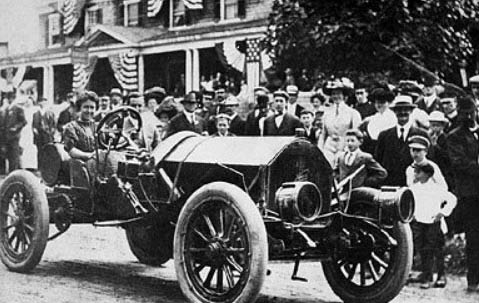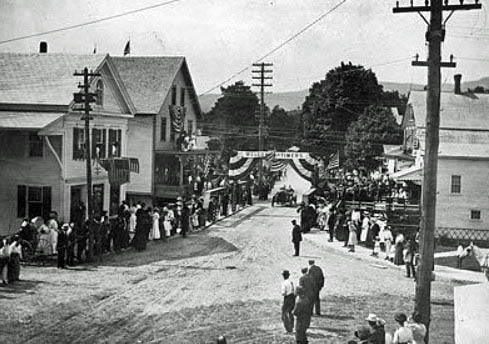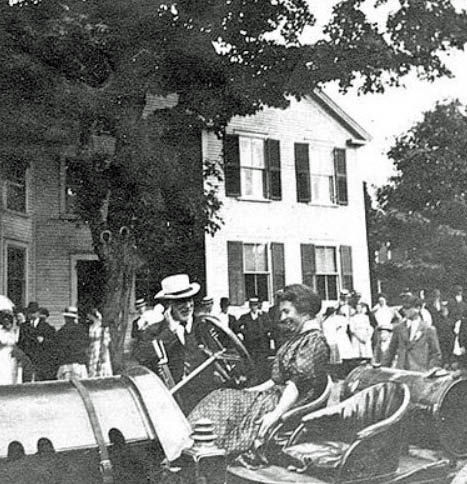The continuing story of Joan Newton Cuneo: “Those daring young (wo)men in their racing machines”

As a follow-up to the May 2012 post on pioneer driver Joan Newton Cueno, reporter Mike Eldred has forwarded his article on Cueno's 1910 automobile exhibition held in Wilmington, Vermont. All photos courtesy of the Pettee Memorial Library/Wilmington Historical Society, Wilmington, Vermont.
Enjoy,
Howard Kroplick
Those daring young (wo)men in their racing machines
by Mike Eldred
WILMINGTON- By the time she raced through the streets of Wilmington in an impromptu exhibition during the 1910 Old Home Week, Joan Newton Cuneo had been banned from competition racing. But she wasn’t banned from racing because of any infraction or failure, Cuneo was banned for the crime of being a woman.
Wilmington’s first “reunion” was held in 1890 and was one of the first in the nation. By 1910, Old Home Week was a well-established Wilmington tradition that included a weeklong schedule of events. On Wednesday, August 17, a crowd gathered in the village for several events. According to an article in The Vermont Phoenix, at 10 am the Shelburne Falls Military Band “gave a pleasing concert from the (Crafts Inn) lawn, attracting a large audience of not only nonresident sons and daughters, but a large portion of the townspeople.”
Many of the visitors, no doubt, traveled to Wilmington by train. Automobiles were still a rare sight, particularly in a rural community like Wilmington. So rare, in fact, that The Vermont Phoenix made note of the fact that one of Wilmington’s returning sons, William A. Davenport, drove his family up from Greenfield in their automobile. At least, part of his family arrived by automobile. “His father, lawyer S.T. Davenport, drew the line on such a mode of locomotion, preferring, as he said, to live out his allotted years rather than sacrifice life and limb to uncertain automobiles.”
No such fear gripped Cuneo, however. According to The Vermont Phoenix, sometime after the band concert, a crowd gathered in the village to watch as Cuneo made several passes through the village on what is now West Main Street and East Main Street. “Mrs. Cuneo drove (her) 90-hp Knox racer over a course laid out between the post office and Courtemanches’s blacksmith shop to the delight and enthusiasm of great throngs which lined both sides of the street. The effort was a strenuous one over a somewhat uneven course, but Mrs. Cuneo succeeded in driving this exhibition mile at the rate of 72 miles an hour.” One photo, shot from an upstairs window at the corner of East Main Street and North Main Street, shows Cuneo roaring down West Main Street, passing under a bunting-festooned banner that reads “Welcome old timers,” a cloud of dust following behind.
Cuneo, a resident of New York City, was married to a well-known banker, Andrew Cuneo, who often accompanied her in the passenger seat during competition. But on the day of her race through Wilmington she was accompanied by Wilmington businessman Verne L. Adams.
Cuneo owned a summer cottage at Lake Raponda, but her ties to Wilmington were more than that of a summer visitor. Her father, John Carter Newton, owned what is now the Wheeler Farm. Cuneo’s family still maintains summer property at Lake Raponda.
It’s unclear whether those in the crowd realized the significance of what they had witnessed. Although a woman driving a car in 1910 was something of a rarity, Cuneo wasn’t any ordinary “woman driver,” she was one of the top race car drivers in the earliest era of American motorsports. In fact, it may have been her extraordinary skill and achievement that doomed her career in a sport that was dominated by male drivers.
Sources are scant, but some suggest Cuneo purchased her first car and learned to drive in 1902. But in a July 1905 New York Times article, she’s quoted as saying she had been driving for five years. At any rate, by 1905 Cuneo was already a skilled and confident driver – confident enough to enter one of the earliest and most grueling competitions ever held in the United States, the famous Glidden Tour.
Sponsored by the American Automobile Association, the first Glidden Tour, held in 1905, was a 1,350-mile jaunt across the eastern United States, from St. Louis to New York. Without the benefit of highway systems designed for cars, paved roads, clear road signs, gas stations or repair shops, heading out on the Glidden Tour was not for the faint of heart. Driving a brass-era car was difficult, requiring great strength and stamina on even the best city roads.
Cuneo was the only woman to enter the inaugural competition, and almost instantly she faced discrimination. Tour officials wouldn’t allow Cuneo to ascend Mount Washington because she was a woman, according to The New York Times. Cuneo vowed to make the run on her own, and do it better than the male drivers.
“I have operated a car five years and know my car far better than a lot of men do,” she said. “If some of the cars went up the course in the time accredited them, I can put my car up in faster time. I believe I could back it, run it sideways, or any old way, and land there in better time than some of the men drivers did.” For her attitude and aptitude, Cuneo was often referred to as the “plucky New York woman.”
Unfortunately, Cuneo’s luck ran out near the end of the tour, when her second gear broke. Cuneo, her husband, and their mechanic worked through the night, cracking the gearbox and swapping the reverse gear with the broken second gear. The car ran out of gas at 2 am in Lenox, MA.
Such breakdowns were typical of the Glidden Tours, and finding replacement parts, field-expedient substitutions, and making on-the-road repairs were a part of the competition, and Cuneo was a competent mechanic in her own right. In a New York Times article announcing her third entry in the Glidden Tour in 1908, it was noted that Cuneo’s husband and a mechanic would again accompany her. Cuneo, however, said she “does not deem the mechanic a necessity on this tour, as she is well-equipped to make all minor repairs that may be required to keep her car close up to the other contestants in the daily runs.”
But endurance races weren’t the only outlet for Cuneo’s automotive prowess. She also set a number of speed records. In fact, it was one such record that may have sealed the fate of women in AAA competition. In February 1909 Cuneo was in New Orleans for the Mardi Gras automobile races. As usual, she was competing with the men – there was no division of the sexes in auto racing. In a five-mile timed race, Cuneo broke her own world record time of 6:04 by nearly a minute with a new world record time of 5:05. But in the 50-mile race, she came dangerously close to besting Ralph De Palma, one of the top male racers of the day.
In his Fiat Cyclone, De Palma completed the race in 51 minutes 37 seconds. Cuneo was one of the few top race drivers of the era to compete in an American-made automobile. Driving her Knox Giant, made in Springfield, MA, Cuneo came in second with a time of 52:40. Before the end of the year, women were banned from racing – although the AAA never suggested that Cuneo’s performance was the reason.
At the time, the AAA was the controlling authority for automobile racing. Their ruling essentially barred women from any competition, save women-only exhibition racing. Although her competition days may have been over, her driving days certainly weren’t. In 1911, in fact, she was said to be the “fastest woman in the world” after she logged a speed of 112 miles per hour. Also in 1911, she pleaded guilty and was fined $10 for driving 43 mph through the streets of Yonkers. Cuneo said she didn’t think the speed was too fast.
In October 1910, just a few months after her exhibition at Wilmington Old Home Week, Cuneo was back in Wilmington driving her new Renault American Special. According to an “automobile trade gossip” piece in The New York Times, Cuneo’s first trip in the car was from New York, through the Berkshires, to Wilmington. “The last half of the day’s run, as well as most of those that followed, was over old-fashioned mountain roads with sand, rocks, water breakers, steep, winding grades, and all of the other truly rural features of pure wilderness driving.”
 Joan Newton Cuneo in her Knox Giant roadster, in front of the Crafts Inn in 1910.
Joan Newton Cuneo in her Knox Giant roadster, in front of the Crafts Inn in 1910.
 Joan Newton Cuneo races her roadster over the bridge in the center of Wilmington, Vermont as crowds packed the side of the road during Old Home Week in 1910.
Joan Newton Cuneo races her roadster over the bridge in the center of Wilmington, Vermont as crowds packed the side of the road during Old Home Week in 1910.
 Joan Newton Cuneo receives congratulations after her race through the center of Wilmington.
Joan Newton Cuneo receives congratulations after her race through the center of Wilmington.


Comments
I would really like some in-depth technical detail on the Knox Giant. It seems like an amazing car destined for an amazing driver.
My family has a big silver cup from one of the Glidden tours.We also have many original pictures of her and her cars.She was my father’s grandma.I actually sold a letter written to her by a opera singer named Enrico Caruso I believe? Sounded like they had something going on the side?
I bought the photo and letter on EBay years ago- my family is Cuneo- from NY metro area- maybe some relative?
Click here to Download this file